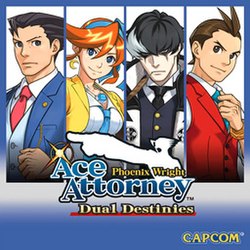Phoenix Wright: Ace Attorney - Dual Destinies
| Phoenix Wright: Ace Attorney − Dual Destinies | |
|---|---|

English cover art, featuring (from left to right) Phoenix, Athena, Blackquill, and Apollo
|
|
| Developer(s) | Capcom |
| Publisher(s) | Capcom |
| Director(s) |
|
| Producer(s) | Motohide Eshiro |
| Designer(s) |
|
| Artist(s) | Takuro Fuse |
| Writer(s) |
|
| Composer(s) | Noriyuki Iwadare |
| Series | Ace Attorney |
| Engine | MT Framework Mobile |
| Platform(s) | Nintendo 3DS, iOS |
| Release date(s) |
Nintendo 3DS
|
| Genre(s) | Adventure, visual novel |
| Mode(s) | Single-player |
| Aggregate score | |
|---|---|
| Aggregator | Score |
| Metacritic | 81/100 |
| Review scores | |
| Publication | Score |
| Destructoid | 9.5/10 |
| Famitsu | 37/40 |
| Game Informer | 8/10 |
| GamesRadar | 4/5 |
| IGN | 7.2/10 |
Phoenix Wright: Ace Attorney − Dual Destinies, known in Japan as Gyakuten Saiban 5 (逆転裁判 5?, lit. "Turnabout Trial 5"), is a visual novel adventure video game developed and published by Capcom. It is the fifth main entry in the Ace Attorney series, and was originally released for the Nintendo 3DS in 2013, with an iOS version following in 2014.
The game is set around a year after the previous game, Apollo Justice: Ace Attorney, in a time where the court system has entered a dark era of false charges and fabricated evidence. The player takes the roles of three defense attorneys Phoenix Wright, Apollo Justice and Athena Cykes, who defend their clients in multiple cases and try to restore confidence in the courts. The gameplay is split into investigation sections, where the player searches for evidence and talks to witnesses, and trials, where they search for inconsistencies between witness testimonies and the evidence. The player can use some character-specific gameplay mechanics: Phoenix can see "psyche-locks" over witnesses who are hiding something; Apollo can spot visual cues in witnesses that indicate lying; and Athena can detect conflicting emotions in witnesses' voices.
The development team included the producer Motohide Eshiro, the directors Takeshi Yamazaki and Yasuhiro Seto, and the composer Noriyuki Iwadare. Due to the game being made a long time after Apollo Justice, the developers wanted it to make a big impact, and came up with the idea of the player working to revive the trial system. As it was the first Ace Attorney game on the Nintendo 3DS, the developers made use of 3D graphics; they focused on preserving the look of the earlier Ace Attorney games' 2D art, and wanted to ensure that the graphics looked better than those in the simultaneously developed Professor Layton vs. Phoenix Wright: Ace Attorney. The game's localization was directed by Janet Hsu, and was incorporated into the overall development, allowing the localization team a larger degree of insight into the developers' intentions. The game was generally well received by critics, who praised the visuals and character art, but criticized the game for sometimes not accepting logically valid input during trials. The game achieved the estimated sales, which were high compared to how the franchise had performed in the past.
...
Wikipedia
